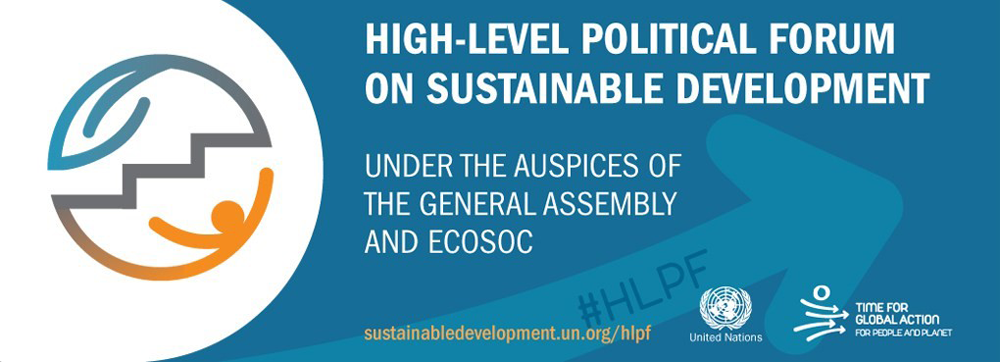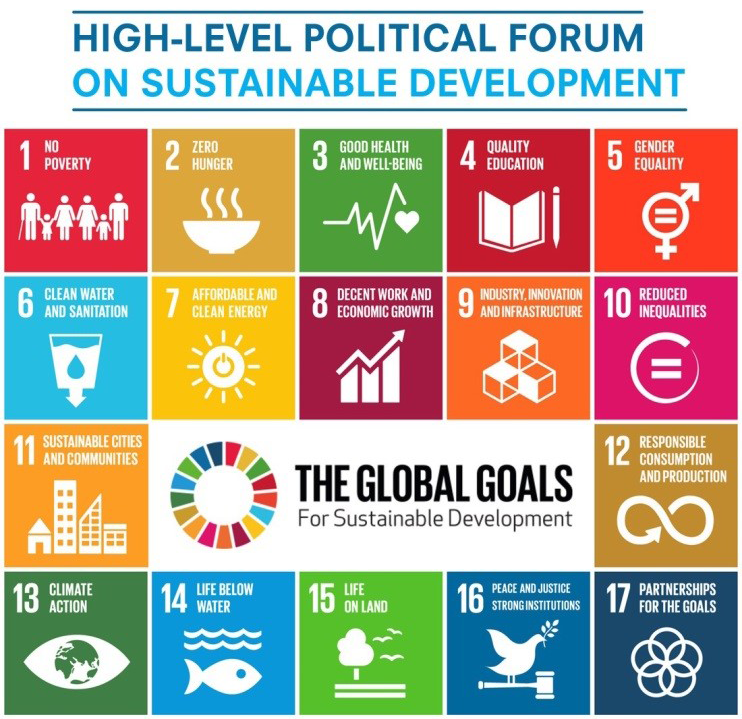UN High Level Political Forum on Sustainable Development
As a key contributor to the UN Economic and Social Council's High Level Political Forum on Sustainable Development, APA will promote our research and policy guides about tools, techniques, and best practices.
Summer 2019
High-Level Political Forum 2019: Implementation of the Sustainable Development Goals (SDGs)
The meeting of the High-Level Political Forum (HLPF) on Sustainable Development in 2019 convened in mid-July in New York. APA has been an accredited member of the Economic and Social Council of the UN since 1997 and participates in meetings and in reviewing and commenting on reports.
Last year, for example, we solicited input from APA members on the UN Habitat Strategic Plan and the final version reflects a strong approach to planning and the governance structures needed to support planning. APA and its legislative and policy leadership have produced excellent policy guides over the years, and the guides support our efforts internationally both for drafting comments on reports and programs and for sharing with other planners and officials globally.
The theme of this year's HLPF is "Empowering people and ensuring inclusiveness and equality." Each year, specific Sustainable Development Goals (SDGs) are reviewed. This year the goals to be reviewed in depth include:
Goal 4. Ensure inclusive and equitable quality education and promote lifelong learning opportunities for all
Goal 8. Promote sustained, inclusive and sustainable economic growth, full and productive employment and decent work for all
Goal 10. Reduce inequality within and among countries
Goal 13. Take urgent action to combat climate change and its impacts
Goal 16. Promote peaceful and inclusive societies for sustainable development, provide access to justice for all and build effective, accountable and inclusive institutions at all levels
Goal 17. Strengthen the means of implementation and revitalize the global partnership for sustainable development
These regular voluntary reviews of the 2030 agenda are led by the governments and their agencies of the countries participating, along with stakeholders like APA.
The meetings also provide a platform for partnerships, including through the participation of major groups and other relevant stakeholders. In 2019, 47 countries volunteered to present their national voluntary reviews to the HLPF. The current administration in the U.S. has not embraced multinationalism to the extent that other administrations have and has not prepared a Voluntary National Report (VNR).
New York City took the bold step of initiating and submitting a Voluntary Local Report, demonstrating its commitment and progress on implementing the SDGs. Planners should find this report of interest because it links the City's Strategic Plan, OneNYC, to the implementation of the SDGs. It also uses infographics to make the report accessible to a wide audience and reflects a wide variety of public involvement.
The Voluntary Reports that have been submitted are all available online. The Canadian Report might be of particular interest as CIP is one of our Global Planners Network partners.
APA will participate in the upcoming COP 25 focusing on climate change in December 2019 and at the World Urban Forum in Abu Dhabi, in February 2020.
Contact APA International Director Jeff Soule at jsoule@planning.org for more information.
Summer 2018
Water and Health
The key topics on the UN High Level Political Forum on Sustainable Development agenda include the critical role of water in meeting the Sustainable Development Goals.
APA has a variety of resources in this area which we are sharing with our colleagues. In addition, our Plan4Health initiative is finding its way into discussions on sustainable development and resilience. Finally, today's discussions engage the issue of mobility and access to transportation options as a key driver of both equity and economic development.
Here is a sample of the discussion from July 2018:
Water and the SDGs — The Crucial Common Denominator
By Gilbert F. Houngbo
Chair of UN-Water, President of the International Fund for Agricultural Development

When a human baby is born, 75 percent of its body mass is water. We are made of water and, like all living creatures on our planet, we would wither and die without it.
Today, more than 2 billion people lack access to safely managed water services. Around 4.5 billion children, women and men live without safely managed sanitation services. As a result, it is estimated that more than 340,000 children die every year.
The world's ecosystems, economies, energy and human settlements – all are at risk if we fail to achieve SDG 6: water and sanitation for all by 2030.
Here are three ways that progress on SDG 6 will drive progress in energy (SDG 7), cities (SDG 11), sustainable consumption and production (SDG 12), and protecting life on land (SDG 15).
1. Water and sanitation make cities safer and nicer places to live
The global urban population is set to grow from around 4 billion today to over 7 billion by 2050 (UNESCO 2012).
The ancient city of Rome was able to sustain a population of around 1 million people in 1 AD largely because its citizens had access to water that was kept separate from a large-scale sewer system. But as we know all too well, when people live without safe, affordable, reliable water supply and sanitation, the consequences are devastating.
If towns and cities of the future are to be inclusive, safe, and sustainable, their inhabitants need safe drinking water and sanitation. This is not only a social good; investing in safe water also offers economic opportunities. For example, the introduction of innovative and affordable water technologies can create employment in new services and industries.
2. Clever use of water and waste will help energy and economies
Today, an ever-increasing and more affluent global population is demanding an ever-increasing amount of stuff. Manufacturing requires water, from around 2,500 litres to make a cotton t-shirt to around 12,000 for a smart phone. And because of the way we produce energy, roughly 75% of all industrial water withdrawals are used for energy production (UNESCO, 2014). There will need to be much more support for the development of less water-intensive renewable energy, such as hydropower and wind.
Agriculture is a major consumer of water. The safe reuse of wastewater – for agricultural irrigation, municipal purposes, industrial washing and cooling etc – can help us create more circular, sustainable production and consumption patterns. Also, improved sanitation systems and treatment plants can generate fertilizer from human and animal waste that could be used in farming or turned into biofuels.
3. Using nature-based solutions helps humans and the environment
Water's journey begins and ends in nature. So, any threat to the source of all our water is a mortal threat to human health.
Globally, over 890 million people practise open defecation, and more than 80% of wastewater flows back into the environment without being treated or reused.
In addition there is the growing issue of the degradation of our natural environment. At a time when climate change is resulting in more extreme weather events and disasters, we cannot afford to further degrade our environment. As things stand, the number of people at risk from floods is projected to rise from 1.2 billion today to around 1.6 billion in 2050.
One way to protect life and water supply is to harness nature itself — restoring forests, grasslands and natural wetlands, reconnecting rivers to floodplains, creating buffers of vegetation along water courses.
These nature-based solutions are not a panacea but, alongside human-made water and sanitation infrastructure, they can help us live in harmony with the ecosystems that literally keep us alive.
As we look ahead to 2030, the much-talked-about 4th industrial revolution offers opportunities never seen before in our sector, such as blockchain-based technologies that can improve water use in agriculture; the "Internet of Things" that will enable more connections and a greater exchange data; and satellite images that can help us track the quality of our ecosystems and implement strategies to reduce the risk of disaster.
New technologies will be essential in creating positive and sustainable relationships between seemingly disparate areas — such as economies, energy, human settlements and ecosystems – to allow for a more sustainable future.
Underlying the apparent intricacies of the 2030 Agenda is one simple truth, underscored by SDG 6, that every person on our planet will always need water and sanitation to survive and thrive.
‘Health for All' Is a Way to Build Sustainable and Resilient Societies
By Prof. Dr. Ilona Kickbusch
Director of the Global Health Centre
Graduate Institute of International and Development Studies and Co-Chair of the UHC2030 Steering Committee

How can we create sustainable and resilient societies? Health, undeniably, plays a foundational role. Good health allows children to learn and adults to earn; it helps people escape from poverty; it addresses social and gender inequities and provides the basis for wellbeing, social cohesion, health security and long-term economic development.
The Sustainable Development Goals (SDGs) set a broad and ambitious agenda for a safer, fairer and healthier world with no one left behind. Achieving universal health coverage (UHC) by 2030 is a core driver to promote physical and mental health and well-being, and will also support the achievement of health-related SDGs.
UHC means that all people and communities have access to needed quality health services without risk of financial hardship. To achieve UHC, we must effectively strengthen health systems to make them sustainable and resilient. UHC also means building progressive pathways that endeavor to first reach the most vulnerable and marginalized populations to ensure no one is left behind. Countries that make progress towards UHC will also make progress towards other health-related targets across different sectors and towards all the SDGs.
Sustainable and resilient health systems matter for society. By resilience, we mean the capacity of actors, institutions and populations to prepare for and respond to health crises.
The worldwide resurgence of dengue fever, the global spread of multidrug-resistant tuberculosis (MDR-TB), and recent outbreaks of Ebola, Middle East Respiratory Syndrome, avian influenza, and the Zika virus have shown how epidemics can spread rapidly in the absence of strong responsive and resilient health systems. No nation is immune to the growing global threat that can be posed by an isolated outbreak of infectious disease in a seemingly remote part of the world. However, with strong health systems countries are better able to prevent, detect, and respond effectively to these crises, thus dramatically reducing the loss of life, community disruption, and economic costs of such events.
UHC is an ambitious target, with its own set of challenges. Fragmentation of efforts by a range of actors and the financing of health are both key issues to address. In order to achieve UHC, we must build resilient health systems that are funded primarily by public finance, and based on primary health care. They must deliver integrated, comprehensive people-centred and quality health services for all, while taking necessary measures to protect households from financial hazards due to health expenditures.
These efforts should be led by national governments, in support of national health policies and plans, building on and strengthening existing sector-wide processes to avoid fragmentation but with the collaboration of other country and global health stakeholders. The progressive realisation of the right to health through UHC is primarily a national responsibility, but can be assisted through regional and global solidarity, exchange and international cooperation.
Under the auspices of UHC2030, there are new opportunities to reach out and draw in all the actors that need to be on board. UHC2030 is a movement to strengthen health systems for UHC. A range of partners including governments in low-, middle- and high-income countries, development partners, civil society organisations, media and the private sector are coalescing around a set of key principles to guide their action in prioritising and implementing health systems strengthening. These principles identified by the UHC2030 global compact for progress towards universal health coverage are:
- Leave no one behind: a commitment to equity, non-discrimination and a human rights based approach
- Transparency and accountability for results
- Evidence-based national health strategies and leadership
- Make health systems everybody's business with engagement of citizens, communities, civil society and private sector
- International cooperation based on mutual learning across countries and development effectiveness principles.
UHC2030's approach promotes policy dialogue between the government health sector authorities and all people, to ensure multi-stakeholder and multi-sectoral actions in health system strengthening at global, regional and country levels. The commitment and actions of our partners injects new political energy into the growing global movement for UHC and as we forge new relationships, allegiances and networks, we find we are stronger together to reach our goal.
Summer 2018
APA and Partners Engage UN High-Level Political Forum

As a key contributor to the UN Economic and Social Council's High Level Political Forum on Sustainable Development, APA will promote our research and policy guides about tools, techniques, and best practices.
Our efforts through APA's Sustaining Places initiative demonstrate the relevance of our work to the Forum. We will also represent our allies in the Global Planners Network.
As previously reported, APA is engaged in Planners for Climate Action, an international effort to share practices, educate planners and officials alike, identify research targets and inform international forums such as this about the key role of planners in climate change and sustainability. Bruce Stiftel, FAICP, Georgia Institute of Technology will participate in the forum, too.
Short reports from the forum will be featured on the web, and a longer report will follow. Among the benefits will be the lessons shared from countries around the world on what planners are doing to promote healthy, resilient communities. APA is one of the several participants in a side event focusing on the importance of cultural and natural heritage in meeting the indicators established by the Sustainable Development Goals.

Background
The establishment of the United Nations High-level Political Forum on Sustainable Development (HLPF) was mandated in 2012 at the United Nations Conference on Sustainable Development (Rio+20), "The Future We Want."
The Forum meets annually under the auspices of the Economic and Social Council for eight days, including a three-day ministerial segment and every four years at the level of Heads of State and Government under the auspices of the General Assembly for two days.
The HLPF is the main United Nations platform on sustainable development and it has a central role in the follow-up and review of the 2030 Agenda for Sustainable Development the Sustainable Development Goals (SDGs) at the global level. General Assembly resolution 70/299 provides further guidance on the follow-up and review of the 2030 Agenda and the SDGs.
As part of its follow-up and review mechanisms, the 2030 Agenda encourages member states to "conduct regular and inclusive reviews of progress at the national and sub-national levels, which are country-led and country-driven." These national reviews are expected to serve as a basis for the regular reviews by the HLPF. These reviews by the HLPF are voluntary and provide a platform for partnerships, including the participation of major groups and other relevant stakeholders.
More information about the process and the countries presenting is here. The United States is not participating.


